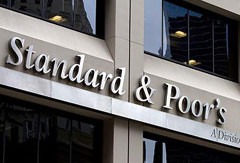Analytics, Economics, Estonia, Latvia, Rating
International Internet Magazine. Baltic States news & analytics
Friday, 02.01.2026, 05:50
Standard & Poor's cuts Latvia's and Estonia’s rating
 Print version
Print version |
|---|
Along with trimming the credit rating, Standard & Poor's assessed Latvia's outlooks as negative. It is already the fourth time since October last year that the agency cuts Latvia's ratings, informs LETA.
The previous downgrade came in February 2009, when Standard & Poor's reduced Latvia's credit rating from "BBB-" to "BB+".
On Monday, the ratings agency Standard & Poor’s decided to lower Estonia’s State rating by one level from A to A-, writes Statistics Estonia.
The ratings outlook remained negative for Estonia.
“The agency’s assessment reflects the view on the risks on the financial markets due to the global economic crisis, which include the risks in the local region,” stated the Deputy Governor of the Bank of Estonia Märten Ross.
He noted that the agency’s decision made on Monday clearly demonstrates the importance of the perspective of a quick accession to the euro area on the reliability of the Estonian economy and on the developments in coming years. “It also confirms yet again the important role of budgetary policy in the current state of global economy,” he added.
Ross stated that the adoption of the euro would significantly increase Estonia’s reliability and will be in near future the main factor in determining the State ratings.
“The central bank estimates that the current outlooks for the Estonian economy are in compliance with the spring outlook compiled by the Bank of Estonia; compliance with the 3-% criterion is still possible, if the solid grip on the budgetary policy will be maintained,” emphasised Ross.
The deputy Governor of the Bank of Estonia also noted that Estonia’s dependence on foreign financing has decreased more than is pointed out by S&P. “Estonia’s current account and current cash flow are in surplus, which has significantly decreased our external vulnerability,” explained Ross, adding that the Estonian banking sector is solid and reliable, even in the current phase of the economic cycle.
The agency emphasized that Estonia’s strengths are the monetary system based on the fixed exchange rate and strong institutions that are dedicated on complying with the budgetary criterion. S&P also underscored Estonia’s low foreign debt and the existence of sufficient State reserves when the global economic crisis broke out – these have been Estonia’s advantages in the current economic situation.
S&P explained keeping Estonia’s State ratings negative with risks due to the economic situation in Estonia’s neighboring countries and the countries that are main trading partners. The agency also notes that the delay in accession to the euro area might affect the State ratings.








 «The Baltic Course» Is Sold and Stays in Business!
«The Baltic Course» Is Sold and Stays in Business!

